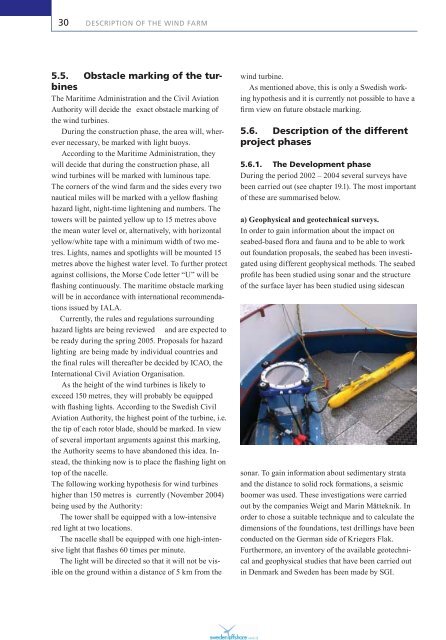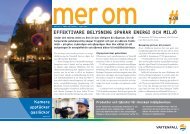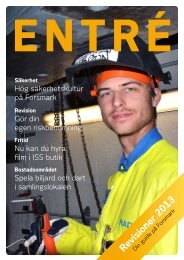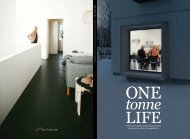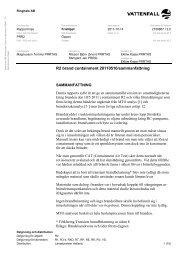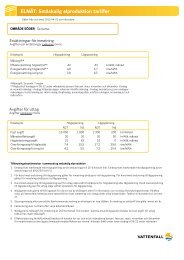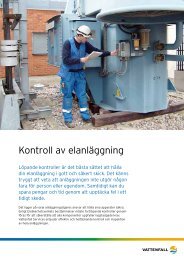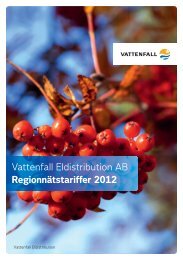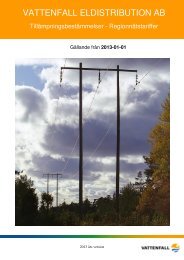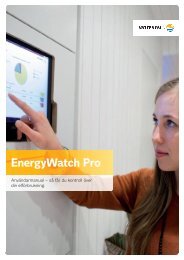This environmental impact assessment for Kriegers flak ... - Vattenfall
This environmental impact assessment for Kriegers flak ... - Vattenfall
This environmental impact assessment for Kriegers flak ... - Vattenfall
You also want an ePaper? Increase the reach of your titles
YUMPU automatically turns print PDFs into web optimized ePapers that Google loves.
30 DESCRIPTION OF THE WIND FARM<br />
5.5. Obstacle marking of the turbines<br />
The Maritime Administration and the Civil Aviation<br />
Authority will decide the exact obstacle marking of<br />
the wind turbines.<br />
During the construction phase, the area will, wherever<br />
necessary, be marked with light buoys.<br />
According to the Maritime Administration, they<br />
will decide that during the construction phase, all<br />
wind turbines will be marked with luminous tape.<br />
The corners of the wind farm and the sides every two<br />
nautical miles will be marked with a yellow ß ashing<br />
hazard light, night-time lightening and numbers. The<br />
towers will be painted yellow up to 15 metres above<br />
the mean water level or, alternatively, with horizontal<br />
yellow/white tape with a minimum width of two metres.<br />
Lights, names and spotlights will be mounted 15<br />
metres above the highest water level. To further protect<br />
against collisions, the Morse Code letter “U” will be<br />
ß ashing continuously. The maritime obstacle marking<br />
will be in accordance with international recommendations<br />
issued by IALA.<br />
Currently, the rules and regulations surrounding<br />
hazard lights are being reviewed and are expected to<br />
be ready during the spring 2005. Proposals <strong>for</strong> hazard<br />
lighting are being made by individual countries and<br />
the Þ nal rules will thereafter be decided by ICAO, the<br />
International Civil Aviation Organisation.<br />
As the height of the wind turbines is likely to<br />
exceed 150 metres, they will probably be equipped<br />
with ß ashing lights. According to the Swedish Civil<br />
Aviation Authority, the highest point of the turbine, i.e.<br />
the tip of each rotor blade, should be marked. In view<br />
of several important arguments against this marking,<br />
the Authority seems to have abandoned this idea. Instead,<br />
the thinking now is to place the ß ashing light on<br />
top of the nacelle.<br />
The following working hypothesis <strong>for</strong> wind turbines<br />
higher than 150 metres is currently (November 2004)<br />
being used by the Authority:<br />
The tower shall be equipped with a low-intensive<br />
red light at two locations.<br />
The nacelle shall be equipped with one high-intensive<br />
light that ß ashes 60 times per minute.<br />
The light will be directed so that it will not be visible<br />
on the ground within a distance of 5 km from the<br />
wind turbine.<br />
As mentioned above, this is only a Swedish working<br />
hypothesis and it is currently not possible to have a<br />
Þ rm view on future obstacle marking.<br />
5.6. Description of the different<br />
project phases<br />
5.6.1. The Development phase<br />
During the period 2002 – 2004 several surveys have<br />
been carried out (see chapter 19.1). The most important<br />
of these are summarised below.<br />
a) Geophysical and geotechnical surveys.<br />
In order to gain in<strong>for</strong>mation about the <strong>impact</strong> on<br />
seabed-based ß ora and fauna and to be able to work<br />
out foundation proposals, the seabed has been investigated<br />
using different geophysical methods. The seabed<br />
proÞ le has been studied using sonar and the structure<br />
of the surface layer has been studied using sidescan<br />
sonar. To gain in<strong>for</strong>mation about sedimentary strata<br />
and the distance to solid rock <strong>for</strong>mations, a seismic<br />
boomer was used. These investigations were carried<br />
out by the companies Weigt and Marin Mätteknik. In<br />
order to chose a suitable technique and to calculate the<br />
dimensions of the foundations, test drillings have been<br />
conducted on the German side of <strong>Kriegers</strong> Flak.<br />
Furthermore, an inventory of the available geotechnical<br />
and geophysical studies that have been carried out<br />
in Denmark and Sweden has been made by SGI.


